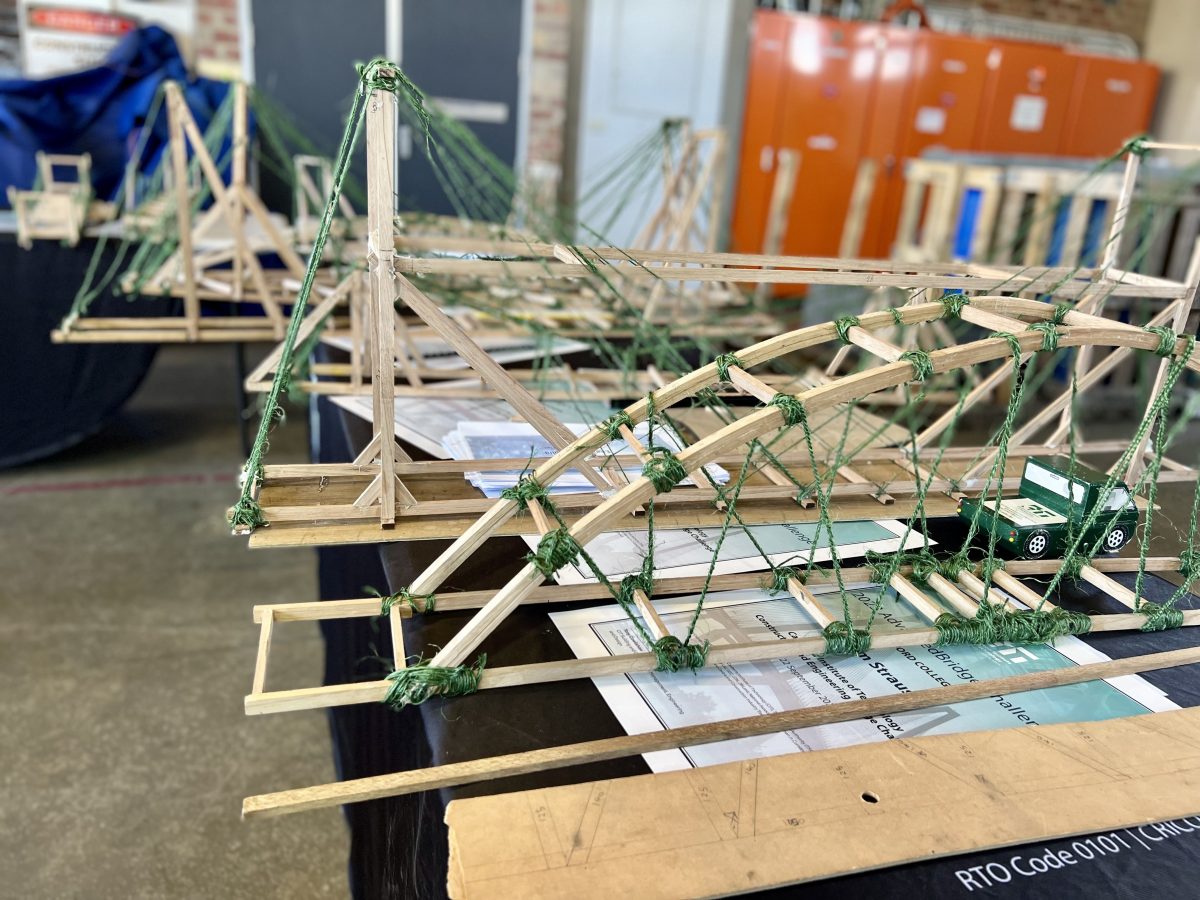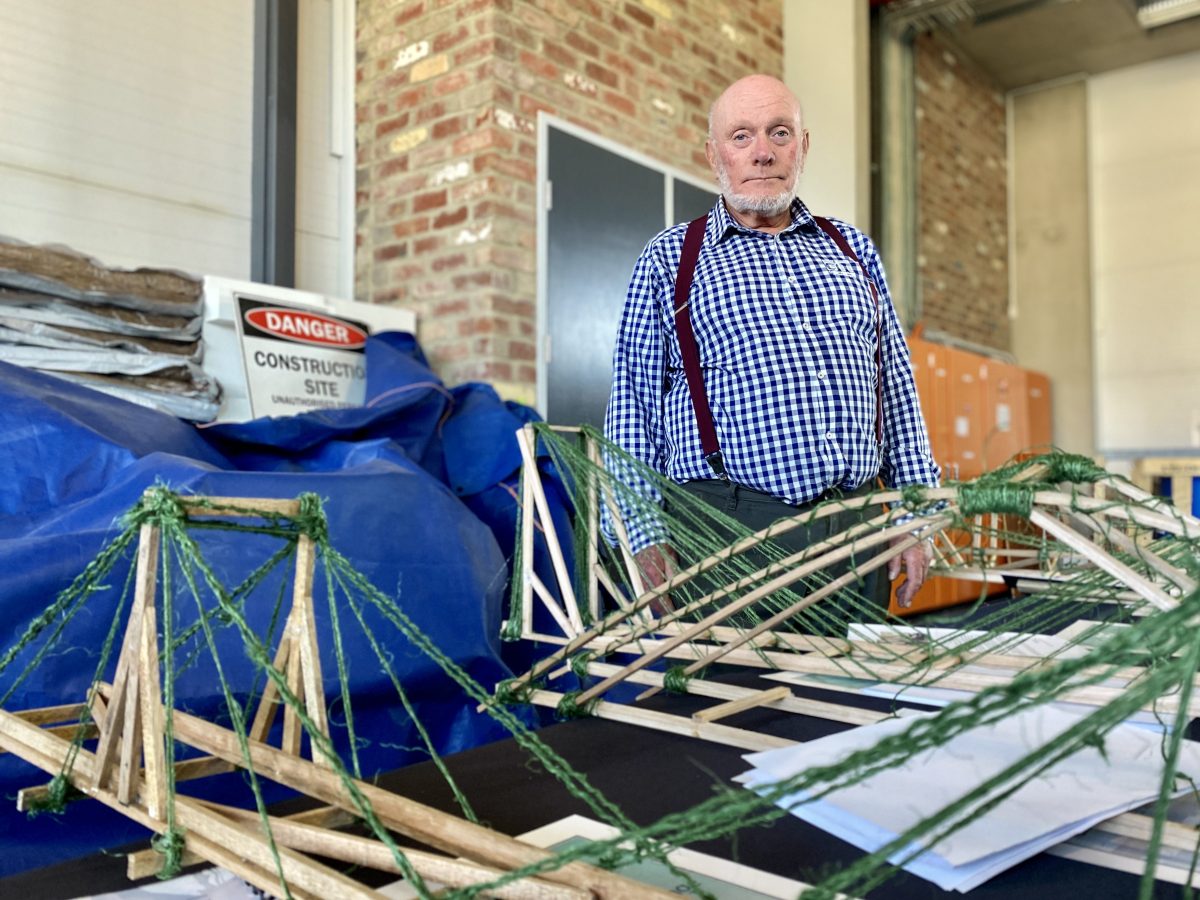
The Radford team with the winning bridge of the CIT Advanced Bridge Competition for 2023. Photo: CIT.
It’s comforting to know Australia’s future bridges will be rated to hold 50 times their own weight.
The Canberra Institute of Technology (CIT) hosted its sixth ‘Advanced Bridge Challenge’ at the Bruce campus last week, where teams of Year 10, 11 and 12 students from across the city’s private and public schools were challenged to engineer miniature suspension bridges capable of holding at least 40 kg.
The building material? Some lengths of timber, string and glue.
The title of overall champion went to the ‘Roebling’ team from Radford College (the team was named after John Roebling, the designer of the Brooklyn Bridge). Their effort only shattered after it was loaded with a staggering 230.5 kg of weight.

Thomas Ahearne and Daniel Christensen from Marist College, holding what remains of their suspension bridge. Photo: James Coleman.
The students were given a few weeks to work together on their bridges, with strict specifications like total length and road width. Teachers and parents were banned from butting in with suggestions.
The finished products – which varied in style from Sydney Harbour to Golden Gate – were rated for their style and design by CIT staff and industry experts before being literally tested to breaking point with heavy metal weights.

A row of bridges ready to be tested at the CIT Advanced Bridge Building Competition. Photo: James Coleman.
It’s been four weeks of construction work outside school hours for Thomas Ahearne and Daniel Christensen from Marist College, only for their team’s effort to splinter into pieces within minutes.
“We felt it could have gone a bit better,” Daniel says.
“We probably mis-glued a few things and probably could have put another X-beam, but that’s about it.”
Their bridge still held out all the way to 67 kg, well over the minimum requirement of 40.
It might have been a “pretty stressful few weeks”, but Thomas and Daniel are eager to pursue engineering as a career, Thomas in civil construction and Daniel in aeronautical engineering.
“I love engineering more now,” Daniel says.
“It’s the actual experience with the process, getting through it, and then the satisfaction afterwards,” Thomas adds.
After all, this is what the competition is all about.

CIT Department of Building and Construction Management, Engineering and Design head Anthony Cowlishaw. Photo: James Coleman.
“The motivation is to engage with students to make them aware of their skills,” CIT Department of Building and Construction Management, Engineering and Design head Anthony Cowlishaw says.
“By designing and building a bridge, it demonstrates their skills in some of the unknown or untested units of what they study at school.”
Every June, the competition is open for students enrolled in years 9 and 10 or enrolled in building and construction Certificate I or II at school. September hosts the “advanced” competition for Year 10 to 12 students.

Kingsford Smith School students at the CIT Advanced Bridge Building Competition. Photo: James Coleman.
Anthony says their first event in 2017 attracted two teams; now there are 18. The number of girls participating has also grown to 25 per cent of participants.
“It’s good to see that area expand construction and engineering as well and having an employment outcome for everyone in a male-dominated industry.”
The ‘Champs 1’ team from Kingsford Smith School in Holt won the ‘Sustainability Award’ on Friday, which takes into account the amount of materials used in construction. The ‘Ninganeers’ from Marist were recognised for the ‘Innovation’ of their bridge’s design and Melba Copland Secondary School 1 for the ‘Lightest Bridge’.



















